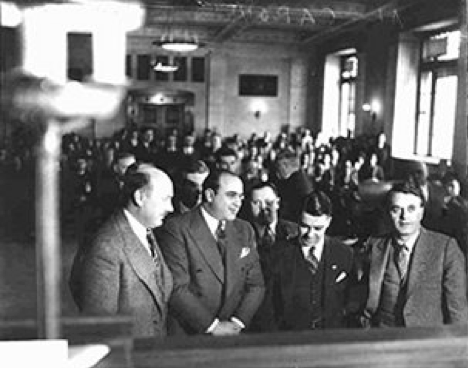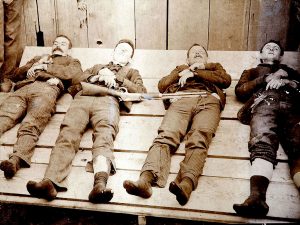About a month after the St. Valentine’s Day Massacre, which occurred in February of 1929, Al Capone and his lawyers were brought into George E. Q. Johnson’s office, the U.S. District Attorney assigned to Al Capone’s case, for questioning for the murder of six men who were allegedly a part of George “Bugs” Moran’s gang. Later in the day, long after Capone had left, an explosion occurred in the same room where Capone had been questioned. Johnson rushed into the room in total shock, knowing that he had been only a few rooms away from sudden death, and could have been yet another of Al Capone’s victims.1
Shortly after the Massacre, President Herbert Hoover was inaugurated President, and one of his first lines of action was to make sure Al Capone went to prison.2 He wanted to send the message that such “brazen criminology would no longer be allowed.”3 As a result, he appointed the top officials of every relevant agency, most importantly the Department of Treasury, to the case since their main focus was to get Al Capone for tax evasion. The Justice Department too was told to gather a group of agents, led by Eliot Ness, to get the crime in Chicago under control, especially the problem of bootlegging alcohol. Initially, Ness was having a lot of trouble, but as his approach became more aggressive, Al Capone became concerned. Capone attempted to bribe Ness and his men, hoping that they would stop disrupting his bootlegging business. Ness was not tempted by Capone’s gracious bribe, and because of that, he and his team were subsequently referred as “The Untouchables.”4

Although Al Capone was being watched and tracked by the government, his bootlegging business continued. Ness raided Al Capone’s brothers’ headquarters, Ralph Capone, and wire-tapped all of his telephones, hoping to receive information about where all of the breweries were. From that point on, the Untouchables destroyed more than $1 million worth of alcohol and equipment. Although they were able to gather much information about speakeasies, none of that information was used in court, unfortunately. Ness’ work was not a waste of time, however, due to his ability to track down many of Capone’s breweries and shut them down.
Another important group interested in bringing Capone to justice is a group called The Secret Six. This group was organized by Robert Randolph, president of the Chicago Association of Commerce. He solicited money from Chicago’s elite, who were afraid of Capone as well, to have the necessary funds to take Capone down. The Secret Six was in agreement with the government to not get involved with Al Capone’s specific crimes, but to help police enforce the law in Chicago. Since most of the crimes in Chicago were related to gang violence and Prohibition, they were able to reduce homicide rates related to these crimes. The Secret Six didn’t specifically participate in Al Capone’s trial, but they were able to save it and helped determine the outcome. They had the responsibility to protect key witnesses, such as Leslie Shumway and Fred Ries, for future trial dates.5
The U.S. Government was working hard to convict Al Capone, and as a result, Capone and his lawyers met with Johnson to discuss a plea bargain. On June 16, 1931, Capone agreed to plead guilty for tax evasion in return for a two-and-a-half year sentence. However, Judge Wilkerson did not approve the deal and denied the bargain on June 30. Capone then withdrew his guilty plea to take his chances with a trial.6 Several witnesses were brought to the stand in October of 1931, including Leslie Shumway, who provided a general ledger containing daily financial reports of liquor sales. Charles Arndt, Chief of Chicago’s Bureau of Internal Revenue, also testified that there was no record of Alphonso Capone paying his income tax. Lastly, Fred Reid testified that Capone was making huge profits, and that those profits were not recorded in any income statement. He said that they were wasted on gambling on horse racing and dog racing.7 According to data collected by the Department of Treasury, between the years 1924 and 1929, Al Capone had made roughly $1 million, and he therefore owed taxes amounting to roughly $215,000.8

During the trial, District Attorney Johnson showed the jury that Capone was successful, and that all the money from his businesses was going to him. Al Capone had extravagant spending habits, but all the money that he spent failed to appear on his income statement. He had expenses, such as fine food, expensive clothing, and a beautiful mansion in Palm Beach Florida. But how was Capone making all of this money? Johnson was able to show through evidence that his casinos and his speakeasies in Chicago were making large amounts of money. To make it inconspicuous, the profits earned were transferred to bank accounts in Miami, where Capone’s associates would pick them up for him.9
On October 11, Michael Ahern and Albert Fink, Al Capone’s lawyers, countered Johnson’s arguments. Ahern claimed that the government wasn’t coming at Al Capone because he wouldn’t pay his taxes. Rather, it was a surreptitious way to put him in jail for all the crimes that were allegedly connected to him. The government was trying to prove that Capone was making an abundance of money, and he failed to pay his taxes. Ahern claimed that his luxurious spending habits had no correlation in the context of the case.10
Many of the other key witnesses had yet to be called to the stand by Johnson, and Al Capone and his lawyers were anticipating that the feds were to put up as many as they could. However, as Johnson approached Judge Wilkerson, he said “Your honor, the government now rests,” leaving Al Capone and Ahern in shock. Ahern and Fink had intended for witnesses from all over to testify on Capone’s behalf, giving evidence of Capone and all of his massive losses due to gambling.11 The major premise of their case was to show that losses in gambling was not taxable; therefore, failure to pay taxes was just a mistake on account of it. They also tried to make the point known that there was no political reasoning behind this case, and that this was just an attempt to pin Capone for the failure to enforce Prohibition laws. Due to the suddenness of Johnson’s rest, Ahern and Fink were not prepared to call their first witnesses; they therefore requested a two-day delay. When Wilkerson denied their request, Ahern asked the judge for ten hours in front of the jury to present their defense, but the judge only granted them four.12

On October 15, 1931, court was in session again. Before the jury re-entered the court room, Ahern had a discussion with Wilkerson about permission to bring up certain points in the case. After Wilkerson denied his permission, Ahern angrily exclaimed that the Constitution was corrupt. He began to say to the jury that this case, again, was merely a way of blaming Capone for the lack of enforcement of Prohibition laws, saying that he was the cause of many gang related deaths. He ended by mentioning that Al Capone was forced to plead guilty for tax liability.
That night, Johnson contemplated what he would say the next morning. On October 16, Johnson began by giving the known fact that every American who exceeds an income of $1,500, must pay an income tax. He went for a simplistic approach by forgetting about all the other crimes that Al Capone had allegedly done in the past. It was simply a case of one man failing to pay his income tax. Johnson mocked Capone and compared him to a false Robin Hood.13 Johnson mentioned the time Capone bought $5,000 worth of diamond belt buckles, and $6,500 worth of meat. It didn’t go back to the poor though; it went to his lavish lifestyle in Florida.
It took the jury over eight hours to come to a verdict. On October 17, 1931 at 10:50 P.M., everyone was called back to court. Wilkerson took his position and asked, “Has the jury decided on the verdict?”14 They replied, “Yes your honor, we find the Defendant guilty on counts 1, 5, 9, 13, and 18, and not guilty on counts 2, 3, 4, 6, 7, 8, 10, 11, 12, 14, 15, 16, 17, 19, and 20.”15 Everyone in the courtroom stood in confusion, and Al Capone had a smirk.16 Capone was called back to court in the following week to receive his sentence. When the week had passed, the judge then repeated in court that Capone would serve five years for each felony, and would be charged $10,000 for each, and then another two years for each of the misdemeanors, with another charge of $10,000 each, in addition to the time that Al Capone had already spent in jail for contempt. Wilkerson subsequently lowered the sentence to eleven years and $50,000.
Finally, two years after the St. Valentine’s Day Massacre, George E. Q. Johnson had finally gotten what he had been working for.17 Unfortunately, he could not get him for all of the gang related violence that he had committed in the past, but he achieved not only his goal, but President Hoover’s as well. This could not have been done without the help from Eliot Ness, and all those who were able to gather information about Al Capone’s income history. This case would go down in history as one of the toughest cases in tax history.
- Dennis E. Hoffman, Scarface Al and the Crime Crusaders: Chicago’s private War against Capone (Chicago: Southern Illinois University Press, 1993), 158-163. ↵
- UXL Encyclopedia of World Biography, 2003, s.v. “Al Capone,” by Laura B. Tyle. ↵
- Dennis E. Hoffman, Scarface Al and the Crime Crusaders: Chicago’s private War against Capone (Chicago: Southern Illinois University Press, 1993), 25. ↵
- UXL Encyclopedia of World Biography, 2003, s.v. “Al Capone,” by Laura B. Tyle. ↵
- Dennis E. Hoffman, Scarface Al and the Crime Crusaders: Chicago’s private War against Capone (Chicago: Southern Illinois University Press, 1993), 296-299. ↵
- Fred D. Parsley, Al Capone: The biography of a self-made man (Freeport, New York: Books for libraries press, 1971), 4-6. ↵
- Dennis E. Hoffman, Scarface Al and the Crime Crusaders: Chicago’s private War against Capone (Chicago: Southern Illinois University Press, 1993), 314-316. ↵
- Encyclopedia of the Great Depression, 2004, s.v. “Al, Capone,” by Robert S. McElvaine. ↵
- Dennis E. Hoffman, Scarface Al and the Crime Crusaders: Chicago’s private War against Capone (Chicago: Southern Illinois University Press, 1993), 306-318. ↵
- Encyclopedia of the Great Depression, 2004, s.v. “Al, Capone,” by Robert S. McElvaine. ↵
- John Kobler, Capone: The Life and Times of Al Capone (New York: Da capo press, 2003), 1-10. ↵
- Jonathan Eig, Get Capone (Simon & Schuster, 2010), 240. ↵
- Jonathan Eig, Get Capone (Simon & Schuster, 2010), 248. ↵
- Jonathan Eig, Get Capone (Simon & Schuster, 2010), 257. ↵
- Jonathan Eig, Get Capone (Simon & Schuster, 2010), 257. ↵
- Jonathan Eig, Get Capone (Simon & Schuster, 2010), 251-258. ↵
- Jonathan Eig, Get Capone (Simon & Schuster, 2010), 297-300. ↵



54 comments
Mckenzie Gritton
I like how the article stayed focused on his arrest of tax evasion rather than his whole life or the murders and crimes committed. Its crazy that they didn’t get him for those crimes but rather for taxes. Tax fraud can really take down anyone. This was a well written article, with great attention to detail!
Vanessa Quetzeri
Al Capone was considered a gangster that dominated organized crime. It’s crazy how little evidence the feds had on him; the fact that they wiretapped his phone meant that he must’ve been very smooth when engaging in crime. He may not have gotten prosecuted for those various crimes but he eventually did end up going to prison for tax evasion.
Nelly Perez
Al Capone really tried not to get caught, but he did anyway with the expenses he had. He used up all of his money for gambling and fancy meals. At first, I thought Ness would go undercover as a member, but he wiretapped the phones instead. There wasn’t much evidence for his case, but he ended up going to prison.
Nicholas Robitille
It was very smart for the federal government to attempt to catch out Capone for his tax evasion charges. Capone was very famous for his multiple gang crimes and the lack of evidence supporting his involvement. For the government to come after his much more chargeable offenses, the prosecutor must have been brilliant. Although Capone was not prosecuted for his many heinous crimes, it was a minor victory for Capone to be put away at all, with his record.
Patricia Arechiga
I remember visiting Alcatraz, which homed Al Capone for a period of time. i didn’t know much about Al Capone except that he was a notorious criminal. It’s honestly mind blowing how much money Al Capone made and basically kept ‘hidden’ from the government. Money is the number one killer as it is the one thing that makes on greedy and selfish. What is upsetting tho, is that he was basically punished for tax fraud but not for his actual crimes. The sentence he received seemed way too short knowing his history and actions. Either way, he was sentenced and at least kept off of the streets.
James Disrud
This was a very interesting article, its funny how Al Capone and his associates did so man illegal things but they went to jail for tax fraud.The method of using tax evasion to take down Al Capone is genius, he did so many bad things, and kept getting away with it, they could not get any evidance against them. It is crazy how his empire rose and fell so quick, all because of tac evasion. This article was very well written, and got me intrested in the era.
Vanessa Sanchez
Al Capone such a very well known gangster. Even though I have heard of him and recognize who he is I honestly don’t know much of his history. Its awesome to see how his partner and himself build such an empire. I believe he was such a threat to the government and they tried doing literally the impossible to get to him. Crazy to say they actually got him but for tax evasion and not for his crime living. That just honestly impact me. It was an amazing article.
Felicia Stewart
This was a very interesting article! Al Capone was a very well known gangster and is arguably one of the most famous in history. Al Capone, as well as his partners, were very smart and strategic people, they thought through their every move before making it, which may be why they got away with so much. This article did a great job of explaining his life and that they finally were able to catch him on something, even though the crime was much less severe and he served much less time.
Sharriah Martinez
I am very fascinated with crime and people who had a significant role/ influence in this. I had heard of the name Al Capone, but i did not know what he did nor his end. It is crazy to know that his partners created an empire of organized crime that the government had to use the tactic of tax evasion in order to get to him and take him down under law with a warrant. This article does a good job of putting into perspective the time era and the stroy of AL Capone.
Cameron Lopez
Ah Al Capone, one of the biggest mobsters around in the 1920’s, with his run with drugs, guns, and even prostitution. How Al Capone and his partners created a literal empire of organized crime that the government had to use the tactic of tax evasion in order to get to him and take him down under law with a warrant. When I think of Al Capone I think of one of the biggest mobsters to begin organized crime in the early 1900’s to the 1960’s with Frank Lucas the next big drug suppliers. Great article all around with great information.